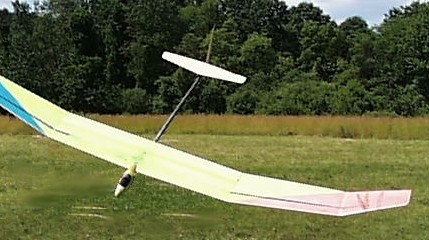Understanding the Allegro 2m
The Allegro 2m is the outcome of his RC 2m design analysis work this year. The Allegro is a surprising sailplane, from a couple of perspectives. One is the Allegro’s “outrageously thin wing”, which has proven so far to be winch-proof. This thin, low drag section, combined with custom designed airfoils (Mark seems to never be satisfied with using a “standard airfoil” for his designs!) leads to a very high performance sailplane.

Drawings and Construction Notes
The Allegro is designed for 2m RES (rudder elevator spoiler) competition tasks. The Allegro uses a set of custom-designed airfoils, tuned for the airframe design parameters. Detailed construction notes and target weights are provided in the plans - please pay close attention to these if you wish your Allegro to have the strength it needs, and the performance it should have!
Allegro Construction
- Allegro 2m Plans: PDF - 36 KB CAD DXF - 507 KB
- Allegro 2m fuselage details: PDF - 28 KB CAD DXF - 411 KB
- Allegro 2m tail shaping data and diagram - 19 KB (Also see: Accurate shaping of solid balsa surfaces without templates)
- Building the Allegro "winch-proof" spar - 10 KB
- Building the Allegro "winch-proof" joiner - 15 KB
- Accurate Shear Web Cutting
Spar and Joiner Construction Notes
The Allegro “winch-proof” spar and joiner system is the result of both laboratory stress to failure testing and real-life testing on our club winches in contest conditions. On the plans, you’ll notice that the spar joiner tapers in width from the center towards the tip. This taper is intentional, and allows the joiner to bend in a controlled curve, presenting a uniform load along the joiner box, rather than a point load at the ends.
The panel spar segments are first individually assembled. Before the spar skin is put on, the core is hogged out at the ends and the joiners and joiner boxes are glued in its place (this procedure is outlined in ‘Building the Allegro “winch-proof” spar’ document above.
The joiner areas get additional spar skin layers since the shear is vastly greater there. Over most of the spar the shear is some fraction of the max wing lift (less than 100 lb on one wing). Over the joiner the shear is equal to the spar cap load – over 1000 lb.
Each spar segment gets built completely separately. There are five of these on the Allegro. The two outer breaks also get a little joiner and its box. This one is so tiny that just splooge flox/epoxy around it rather than use the basswood.
After the completed spar segments (with joiners and boxes) get installed in the cores and the panels are Mylar/bagged, the small outer joiner gets glued into its box making this joint permanent. The joint also gets a glass strip all around. I don’t have any detail for this outer joiner since almost any reasonable joining method would work here. The outer joiner could be plywood for example.
- "winch-proof" spar 4-point bending test results - 2 KB
- "winch-proof" spar test to core failure results - 3 KB
- spar sizing rules derived from test to failure results - 3 KB
Airfoil Coordinates and Polars
| Airfoil | Coordinates | Compufoil COR files | Polars |
|---|---|---|---|
| ag16 | ag16.dat - 4 KB | AG16.COR - 3 KB | ag16_polars.pdf - 31 KB |
| ag17 | ag17.dat - 3 KB | AG17.COR - 3 KB | ag17_polars.pdf - 25 KB |
| ag18 | ag18.dat - 3 KB | AG18.COR - 3 KB | ag18_polars.pdf - 30 KB |
| ag19 | ag19.dat - 4 KB | AG19.COR - 3 KB | ag19_polars.pdf - 25 KB |
| ht08 | ht08.dat - 4 KB | HT08.COR - 3 KB | |
| ht12 | ht12.dat - 3 KB | HT12.COR - 3 KB |
Polar Comparison with Other Typical Airfoils
- Comparison: ag18, ag16, sa7035, rg15 (re100k) - 27 KB
- Comparison: ag18, ag16, sa7035 (re70k) - 20 KB
- Comparison: ag18, ag16, sa7035 (re50k) - 20 KB
Related Construction Notes



